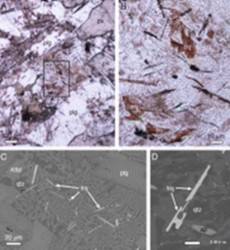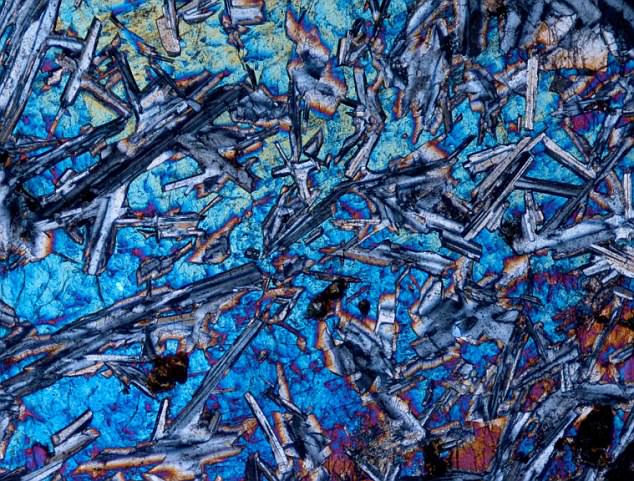[/caption]
When it comes to our natural human curiosity, we want to know if there’s something new out there… something we haven’t discovered yet. That’s why when lunar rock samples were returned, geologists were thrilled to find very specific minerals – armalcolite, pyroxferroite and tranquillityite – which belonged only to our Moon. However, over the years the first two were found here on Earth and tranquillityite was disclosed in specific meteorites. Named for Tranquility Base, site of the first Moon landing, tranquillityite was supposed to be the final hold-out… the last lunar unique mineral… until now.
Birger Rasmussen, paleontologist with Curtin University in Perth, and colleagues report in their Geology paper that they’ve uncovered tranquillityite in several remote locations in Western Australia. While the samples are incredibly small, about the width of a human hair and merely microns in length, their composition is undeniable. What’s more, tranquillityite may be a lot more common here on Earth than previously thought.
Rasmussen told the Sydney Morning Herald, “This was essentially the last mineral which was sort of uniquely lunar that had been found in the 70s from these samples returned from the Apollo mission.The mineral has since been found exclusively in returned lunar samples and lunar meteorites, with no terrestrial counterpart. We have now identified tranquillityite in six sites from Western Australia.”
Why has this remote mineral stayed hidden for so long? One major reason is its delicate structure. Composed of iron, silicon, oxygen, zirconium, titanium and a tiny bit of yttrium, a rare earth element, tranquillityite erodes at a rapid pace when exposed to natural environmental conditions. Another explanation is that tranquillityite can only form through a unique set of circumstance – through uranium decay. Rasmussen explains it’s evidence these minerals were ‘always’ located here on Earth and we share the same chemical processes as our satellite.
“This means that basically we have the same chemical phenomena on the Moon and on Earth.” says Rasmussen. And one of the reasons it has taken so long to be found is, “No one was looking hard enough.”

While it has no real economic value, terrestrial tranquillityite is another good reason mankind should try to preserve pristine regions such as the northeast Pilbara Region and the Eel Creek formation. Who knows what else we might find?
Original Story Source: PhysOrg.com.


>pristine regions such as the northeast Pilbara Region and the Eel Creek formation.
There’s nothing particularly pristine about the region. It has been cattle grazed for well over a century and is extensively mined for iron ore and other minerals. It is largely because of the mineral wealth of the Pilbara that scientific geology has taken place there.
>pristine regions such as the northeast Pilbara Region and the Eel Creek formation.
There’s nothing particularly pristine about the region. It has been cattle grazed for well over a century and is extensively mined for iron ore and other minerals. It is largely because of the mineral wealth of the Pilbara that scientific geology has taken place there.
well its a moon mineral, but the mystery lies in how it landed in western Australia. Well the second picture(A,B,C,D) shows the finely embedded Tranquillityite fragments. the composition of iron, silicon, oxygen, zirconium, titanium and a tiny bit of yttrium and its high erosion rate does excite me…..
PS – Its Beautiful!!! ‘ _ ‘
Yes, it is beautiful! Many minerals are, and more generally microscope samples, since you can get so many coloring phenomena that can be drowned out in daylight. Interference colors are like that. (Though you can certainly see them in daylight, even in many minerals. It is just that their eire luminance shows up better under the microscope.)
As for the mineral, the post mentions that it is native to Earth too:
“Another explanation is that tranquillityite can only form through a unique set of circumstance – through uranium decay. Rasmussen explains it’s evidence these minerals were ‘always’ located here on Earth and we share the same chemical processes as our satellite.”
The blue image is what you are seeing through a microscope with a filter.
We should preserve everything…. who knows what we may find. We should all get extinct so that the environment is preserved and the rest of the animals live in peace.
I’m just so sick of hearing these kinds of words. The world is there for the taking.
Preserving everything and preserving nothing are not our only two options.
I, for one, found the article for more exciting just from the standpoint we are learning so much more than we knew just before the 1970s. Our world is a wonder in diversity of life, culture and rich in it’s ability to astonish us daily. Through science, medicine, engineering, technology and other disciplines. However there was an incorrect statement made: “When it comes to our natural human curiosity, we want to know.” It may be inherent in us all, but so many are deprived (limited education if at all) of their ability to make curiosity happen and many, though educated, refuse to expend themselves of the opportunities available. Let us exploit our abilities in gaining knowledge and not exploit that which may make profits.
Yes. But according to Gapminder statistics, most people have started to get education lately. (At least 80 %, IIRC.) So that isn’t a hinder anymore.
That is thanks to making profits of course, making earlier waste more effective, as well as a synergy with social support. I believe you can get that from those statistics as well, democracy and social medicine is essential for well being in societies.
I don’t think there is any “ought” in the sense of immoral exploitation outside of our own species. Species morals are deriving from interspecies societies. But as I have said before on these pages, it seems we and our pets and even domestics have started to include other species in an extended family. That extends moral responsibility.
Yes. But according to Gapminder statistics, most people have started to get education lately. (At least 80 %, IIRC.) So that isn’t a hinder anymore.
That is thanks to making profits of course, making earlier waste more effective, as well as a synergy with social support. I believe you can get that from those statistics as well, democracy and social medicine is essential for well being in societies.
I don’t think there is any “ought” in the sense of immoral exploitation outside of our own species. Species morals are deriving from interspecies societies. But as I have said before on these pages, it seems we and our pets and even domestics have started to include other species in an extended family. That extends moral responsibility.
Your comment constitutes an unfortunate arrogance… (where are you from?)
If there is god, then he/she/it would want us to flourish on earth, but not destroy it! If it all is random then we should continue to destroy everything we touch, as that kind of humanity will have no impact on history, because history will vanish with us.
Is it all for the taking?
If there is god, then he/she/it would want us to flourish on earth, not destroy it!
If it all is random then we should continue to destroy everything we touch, as that kind of humanity will have no impact on history, because history will vanish with us.
Congrats, nice article.
Surely, all the answers are right under our noses… we just have to wear our spectacles.
If you haven’t discovered it yet, I recommend to take a look at Hazen’s work on mineral evolution. This is a direct test of that:
Hazen notes that different environments have produced different minerals, that evolve as the environment does. IIRC it goes in some 7 stages, with increasing diversity of minerals, something like this:
1. Nucleosynthesis makes elements which form some few ices.
2. Stellar synthesis makes elements that form ~ 10 intergalactic minerals as part of dust particles.
3. Dust aggregation makes shock impacts that form ~ 100 interplanetary minerals as part of asteroid bodies.
4. Asteroid differentiation makes assortment and wet processing that form ~ 500 minerals as part of planetesimal bodies.
5. Atmosphere processes makes chemical redox processing that form some ~ 1000 minerals as part of planet bodies. Here is where the Moon but also Mars places.
6. Biosphere processes makes biochemical oxygen processing that form some ~ 4000 minerals.
I think Hazen places something like 40 – 60 % of minerals as evolved because life did. He is also trying to make use of mineral “fossil” dating as a means to illuminate both abiogenesis (his special interest) and evolution.
For example, IIRC he claims “the boring billion” between ~ 1.5 Ga bp (billion years before present) to ~ 0.5 Ga bp when multicellulars started to diversify has a similar boring mineral record where nothing much new evolved.
If you haven’t discovered it yet, I recommend to take a look at Hazen’s work on mineral evolution. This is a direct test of that:
Hazen notes that different environments have produced different minerals, that evolve as the environment does. IIRC it goes in some 7 stages, with increasing diversity of minerals, something like this:
1. Nucleosynthesis makes elements which form some few ices.
2. Stellar synthesis makes elements that form ~ 10 intergalactic minerals as part of dust particles.
3. Dust aggregation makes shock impacts that form ~ 100 interplanetary minerals as part of asteroid bodies.
4. Asteroid differentiation makes assortment and wet processing that form ~ 500 minerals as part of planetesimal bodies.
5. Atmosphere processes makes chemical redox processing that form some ~ 1000 minerals as part of planet bodies. Here is where the Moon but also Mars places.
6. Biosphere processes makes biochemical oxygen processing that form some ~ 4000 minerals.
I think Hazen places something like 40 – 60 % of minerals as evolved because life did. He is also trying to make use of mineral “fossil” dating as a means to illuminate both abiogenesis (his special interest) and evolution.
For example, IIRC he claims “the boring billion” between ~ 1.5 Ga bp (billion years before present) to ~ 0.5 Ga bp when multicellulars started to diversify has a similar boring mineral record where nothing much new evolved.
Does this provide additional support for the theory that the Moon was formed via a major impact between a Mars-sized planet and the proto-Earth?